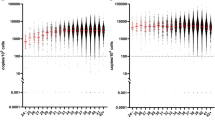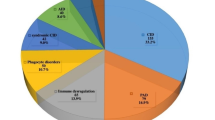Abstract
40 infantile autistic patients were studied. They ranged from 6 years to 15 years of age at entry. 22 were cases of classical infantile autism; whereas 18 lacked one or more clinical defects associated with infantile autism (“pseudoautism”). Of the 22 with classic autism, 21 responded to transfer factor (TF) treatment by gaining at least 2 points in symptoms severity score average (SSSA); and 10 became normal in that they were main-streamed in school and clinical characteristics were fully normalized. Of the 18 remaining, 4 responded to TF, some to other therapies. After cessation of TF therapy, 5 in the autistic group and 3 of the pseudo-autistic group regressed, but they did not drop as low as baseline levels.
Similar content being viewed by others
Abbreviations
- AD:
-
Alzheimer’s Disease
- CFIDS:
-
chronic fatigue immune dysregulation syndrome
- DLE:
-
dialysable leucocyte extract
- DLyE:
-
dialysable lymphocyte extract
- PAS:
-
pseudo-autistic syndrome
- SSSA:
-
symptoms severity score average
- TF:
-
transfer factor
- TA:
-
true autistic
References
Fudenberg HH: The Florence Nightingale disease: A multisystem experiment of nature: A 50 patient five year analysis. In: The clinical and scientific basis of myalgic encephalomyelitis chronic fatigue syndrome. Ottawa, Canada: Hyde BM, 1992; 641–53.
Fudenberg HH & Singh VK. Implications of immunomodulant therapy in Alzheimer’s Disease. Prog Drug Res 1988; 32: 21–42.
A five year follow-up of these AD patients has been published in Fudenberg HH: Heterogeneity of Alzheimer’s Disease: An interpretive review. Mol Neurob 1994; 9: 55–71.
Singh VK, Fudenberg HH, Emerson D & Coleman M. Immunodiagnosis and immunotherapy of autistic children. Ann NY A, 1988; 540: 602–4.
Fudenberg HH & Wybran J. Experimental immunotherapy. In: Fudenberg HH, Stites DP, Caldwell JL & Wells JV, eds. Basic and Clinical Immunology. Los Altos, CA: Lange Medical Pubs 1980; 3rd Ed: 722–36.
Galbraith GMP, Emerson D, Fudenberg HH, Gibbs CJ & Gajdusek DC. Antibodies to neurofilament protein in retinitis pigmentosa. J Clin Inv 1986; 78: 865–9.
Fudenberg HH: Dialyzable lymphocyte extract in neurocognitive dysfunction diseases: Effects of granulocytes percent and degree of donor-patient contact. In: Huo BL, Wang R & Zou ZF eds. 9th International Symposium on TF. Beijing: Xueyuan Press 1992: 149–58.
Fudenberg HH & Pizza G. Transfer Factor 1993: New Frontiers. In: Jucker E, ed. Progress in Drug Research. Boston: Birkhauser Verlag Basel, 1994; 42: 309–99.
Stites DP: Clinical methods of laboratory detection of cell mediated immunity function. In: Fudenberg HH, Stites DP, Caldwell JL & Wells JV, eds. Basic and Clinical Immunology. Los Altos, CA: Lange Medical Pubs 1980; 3rd Ed.
Strauson DO, Walker C, et al. Mechanism of serotonin-induced lymphocyte proliferation inhibition. Cell Immun 1984; 84: 240–52.
Singh VK, Warren RP, Odell JD & Cole WP. Antibodies to myelin basic protein in children with autistic behavior. Brain Beh 1993; 7: 97–103.
Plioplys AV, Greaves A, Kazemi K & Silverman E. Lymphocyte function in autism and rett syndrome. Neuropsychb 1994; 19: 12–16.
Mosier D, Baldelli P, Delbono O, Smith RG. Alexianmu M, Appel S & Stefani E. Amyotrophic lateral sclerosis: immunoglobulins increase Ca2+ currents in a motoneuron cell line. Ann Neurol 1995; 37: 102–9.
Singh VK & Fudenberg HH. Increase of immunoglobulin G3 subclass is related to brain autoantibody in Alzheimer’s Disease but not in Down’s Syndrome. Autoimmun 1989; 3: 95–101.
Fudenberg HH, Whitten HD, Merler E & Farmati O. Is schizophrenia an autoimmune receptor disorder? Med Hypoth 1983; 12: 85–92.
Singh VK: Personal communication.
Fudenberg HH, Pink JRL, Stites DP & Wang AC. Basic Immunogenetics. New York: Oxford Univ Press, 1984; 3rd Ed.
Fudenberg HH, Pink JRL, Wang AC & Ferrara GB. Basic Immunogenetics. New York: Oxford Univ Press, 1984; 3rd Ed.
Since submission of this manuscript, we have learned that Warren, et al. found increased freauency of the null allele at the complement C4b locus of the estended immune response gene haplotype in autism. Warren RP, Singh VK, Cole P, Odell JD, Pingree CB, Warren WL & White E. Increased frequency of the null allele at the complement C4b locus in autism. Clin Exp Immunol 1991; 83: 438–40.
Pandey JP, Fudenberg HH, Virella G, Gotschlich EC, et al. Association between immunoglobulin allotypes and immune responses to haemophilus influenzae and meningococcus polysaccharides. Lancet 1979; 1: 190–2.
Author information
Authors and Affiliations
Rights and permissions
About this article
Cite this article
Fudenberg, H.H. Dialysable lymphocyte extract (DLyE) in infantile onset autism: A pilot study. Biotherapy 9, 143–147 (1996). https://doi.org/10.1007/BF02628672
Issue Date:
DOI: https://doi.org/10.1007/BF02628672




